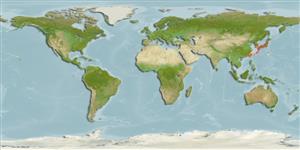Environment: milieu / climate zone / depth range / distribution range
Οικολογία
Θαλασσινό(ά) Υφαλόφιλο(α); εύρος βάθους 1 - 10 m (Ref. 58302). Temperate; 41°N - 22°N, 117°E - 154°W
Northwest Pacific: Japan, Korea, Taiwan. Eastern Central Pacific: Hawaii. Introduced in Mediterranean Sea: Records from Malta (Ref. 95772); North Adriatic Sea, Gulf of Trieste, Italy (Ref. 106699); YYY (Ref. YYY in press, 2016).
Μέγεθος / Βάρος / Age
Maturity: Lm ? range ? - ? cm
Max length : 80.0 cm TL αρσενικό/απροσδιόριστο; (Ref. 559); μεγ. δημοσιευμένο βάρος: 6.4 kg (Ref. 40637)
Inhabits coastal rocky reefs (Ref. 43239). Benthopelagic (Ref. 58302). Juveniles associate with drifting seaweed (Ref. 12114, 12115, 58302).
Life cycle and mating behavior
Γεννητική Ωρίμανση | Αναπαραγωγή | Γεννοβολία | Αβγά | Γονιμότητα | Προνύμφες
Nakabo, T., 2002. Fishes of Japan with pictorial keys to the species, English edition II. Tokai University Press, Japan, pp 867-1749. (Ref. 43239)
IUCN Red List Status (Ref. 130435: Version 2024-1)
Threat to humans
Harmless
Human uses
αλιεία: Εμπορικό(ά); Υδατοκαλλιέργειες: Εμπορικό(ά); αλιεία αναψυχής: ναί
Εργαλεία
Special reports
Download XML
Διαδικτυακές πηγές
Estimates based on models
Preferred temperature (Ref.
123201): 16.1 - 25.2, mean 22 °C (based on 329 cells).
Phylogenetic diversity index (Ref.
82804): PD
50 = 0.5156 [Uniqueness, from 0.5 = low to 2.0 = high].
Bayesian length-weight: a=0.01995 (0.00906 - 0.04395), b=3.01 (2.83 - 3.19), in cm total length, based on all LWR estimates for this body shape (Ref.
93245).
Τροφικό Επίπεδο (Ref.
69278): 3.6 ±0.50 se; based on food items.
Fishing Vulnerability (Ref.
59153): Moderate to high vulnerability (52 of 100).
Nutrients (Ref.
124155): Calcium = 13.1 [5.4, 24.6] mg/100g; Iron = 0.203 [0.100, 0.367] mg/100g; Protein = 19.4 [18.1, 20.6] %; Omega3 = 0.212 [0.105, 0.438] g/100g; Selenium = 7.93 [3.45, 19.64] μg/100g; VitaminA = 17.5 [3.8, 83.2] μg/100g; Zinc = 0.464 [0.286, 0.749] mg/100g (wet weight);
